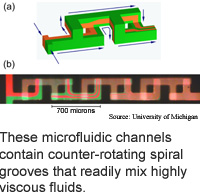
Microchannel folds fluids
Mixing a pair of liquids may seem like
a quick easy task, but at very small scales turbulence disappears, making
mixing more like kneading dough than stirring cream into coffee.
Researchers from the University of Michigan have devised a passive
mixing scheme that causes the flow of liquids on a microfluidic chip to
split, rotate and recombine so that the fluid repeatedly folds in on itself
and so mixes relatively quickly despite the lack of turbulence.
The folding process is akin to making a puff pastry, according
to the researchers. The flow is split into two identical streams, then
rotated in opposite directions and recombined, which cuts the size of
any non-mixed portions in half. After a few folds, the non-mixed portions
become small enough that diffusion is enough to mix the liquids.
The method can be easily integrated into existing microfluidic
platforms, or labs-on-a-chip, according to the researchers.
Key to the method's utility is it does not take a lot of space
on a chip. Other passive fluid mixing schemes involve flowing the liquids
through relatively long channels, according to the researchers.
The method could be used in practical commercial applications
in five years, according to the researchers. The work appeared in the
March 22, 2004 issue of Applied Physics Letters.
Solar crystals get 2-for-1
Shape-shifting remakes interfaces
Evolution trains robot teams
Group dynamics play out in VR
Briefs:
Nanotube sparks could cool chips
Nanotube makes metal transistor
Junctions expand nano railroad
Indexes bolster ebook search
Microchannel folds fluids
Electricity turns plastic green

Research Watch blog
View from the High Ground Q&A
How It Works
RSS Feeds:
News
Ad links:
Buy an ad link
Ad links: Clear History
Buy an ad link
|
TRN
Newswire and Headline Feeds for Web sites
|
© Copyright Technology Research News, LLC 2000-2010. All rights reserved.